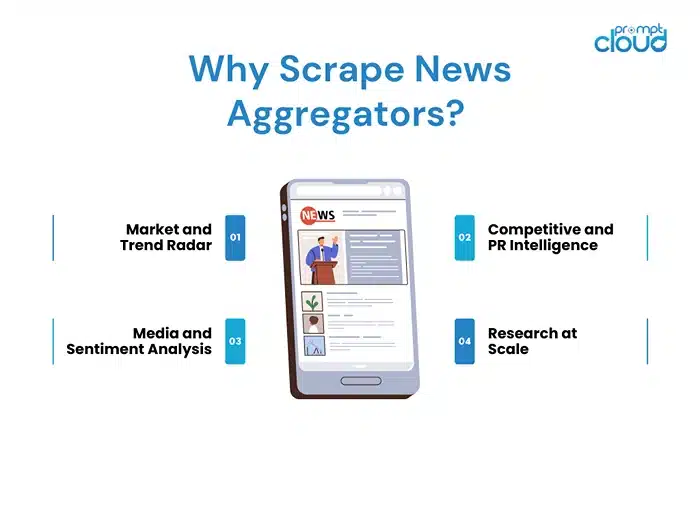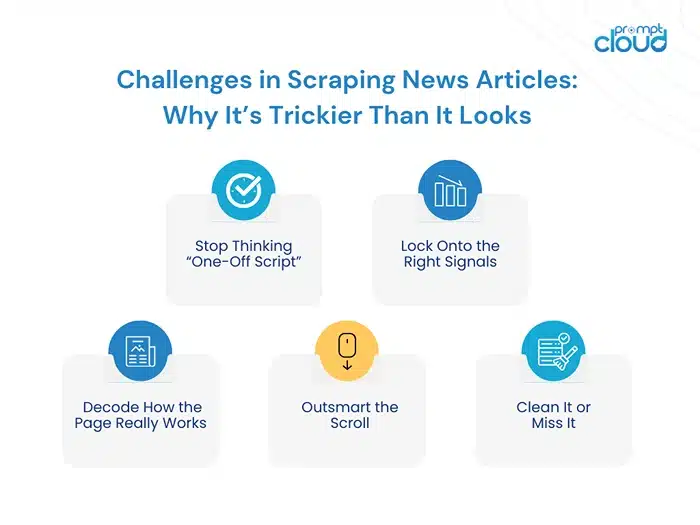
**TL;DR**
News today moves at hurricane speed. Google News indexes over 50,000 articles a day, Apple News personalizes headlines for massive audiences, and most teams still try to track it all by hand, the equivalent of chasing lightning with a butterfly net.
Scraping a news aggregator flips the script. Instead of wading through noise, you build a real-time, structured feed of the stories that actually matter, headlines, timestamps, sources, and sentiment. It’s how analysts spot breaking trends before competitors, how researchers cut research time in half, and how product teams catch the next market shift before the headlines age out.
In this guide, you’ll learn:
- Why aggregators are goldmines: They consolidate thousands of sources into one place if you know how to tap them.
- Where teams get stuck: Dynamic pages, anti-bot walls, infinite scroll, and how to outsmart them.
- How to do it right: A step-by-step playbook from inspecting selectors to scaling with automated web scraping solutions.
- When speed is the edge: In news, hours matter; scraping cuts that lag to minutes.
Bottom line? Stop scanning. Start scraping. The headlines that shape your industry are already out there; the only question is whether you’ll catch them before your rivals do.
Why Scraping News from Aggregators Matters Now
News today moves at hurricane speed. Google News unleashes tens of thousands of headlines a day. Apple News personalizes feeds for a global audience. And still, most teams are stuck copy-pasting into spreadsheets, crossing their fingers they don’t miss the big one. That’s not strategy; that’s playing catch-up with a firehose.
But here’s the shift: every headline carries signals that go beyond the story itself. A spike in coverage around “AI regulation,” the sudden quiet on a competitor’s product, or a surge of regional stories before a market shake-up: these are clues. And if you’re only skimming your favorite publications, you’re already late. Aggregators like Google News, Apple News, and Flipboard serve as signal amplifiers, pulling content from thousands of sources in real-time. Scraping them isn’t about hoarding articles; it’s about catching those signals while they’re still warm.
The stakes are high. Over 60% of adults get their news online daily (Pew Research, 2024), and companies are treating news data as critical intel. Whether you’re a data analyst spotting trends, a media researcher tracking narratives, or a product team keeping tabs on competitors, structured access to news aggregators gives you an edge that gut instinct can’t.
In this guide, we’ll break down exactly how to turn that endless feed into actionable data, without getting lost in technical jargon. You’ll see why scraping news matters, the traps teams fall into, and a step-by-step playbook to do it right. And yes, we’ll also cover when it makes sense to automate with web scraping solutions so you can focus on insights, not infrastructure.
Why Scrape News Aggregators?
Scraping a news aggregator isn’t about collecting random articles; it’s about building a live radar for what’s shaping your industry. Think about it: one headline might tell you what happened. A thousand headlines from hundreds of sources? That tells you why it happened, how people are reacting, and where the story is headed next.
Here’s why the smartest teams are already doing it:

1. Market and Trend Radar
Trends don’t start on Wall Street or in boardrooms; they show up first in the news cycle. A sudden surge of articles around “green hydrogen” or “chip shortages” often signals where the market is moving before the quarterly reports catch up. Global news analytics reports show companies monitoring aggregated news feeds spot industry shifts up to 3 months earlier than those relying only on historical sales data.
2. Competitive and PR Intelligence
Competitors won’t email you when they launch a new feature or quietly expand into a new region. News aggregators surface that information in real time. By scraping Google News or Apple News, you can track every mention, from glowing reviews to brewing PR crises. It’s how brands avoid flying blind and respond to small issues before they go viral.
3. Media and Sentiment Analysis
Not all coverage is good coverage. It’s not just about counting mentions; it’s about analyzing the tone. Scraped news data lets you run sentiment analysis across thousands of articles to see how your brand, competitors, or entire industries are being perceived. One study found that brands tracking sentiment in news sources saw a 20% improvement in crisis response times.
4. Research at Scale
For journalists, policy researchers, and academics, scraping news aggregators slashes research time. Instead of searching outlet by outlet, you get structured data across every source relevant to your topic. That means less “find and copy” and more analysis and storytelling.
The bottom line? Scraping news aggregators gives you an always-on feed of structured intelligence. When news breaks, you’ll know first. When narratives shift, you’ll see it in the data. And when competitors make moves, you’ll already have the context. That’s a serious edge in a world where attention windows are measured in hours, not weeks.
How News Aggregators Work: The Engine Behind the Headlines
Before you can scrape effectively, you need to know what you’re scraping. A news aggregator isn’t just a website dumping headlines; it’s a constantly running machine pulling stories from thousands of sources, filtering them, and ranking what you see. Think of it as the backstage crew of the news world, invisible but essential.
How They Pull the News
Platforms like Google News and Apple News ingest content through multiple pipes: publisher RSS feeds, structured sitemaps, and sometimes direct partnerships with outlets. That’s why a breaking story from a small regional blog can show up next to a front-page Wall Street Journal piece; the aggregator doesn’t care about size, just relevance and recency.
And the scale is staggering: Google News processes tens of thousands of new articles every day, grouping them into topics, tagging publishers, and even clustering different takes on the same event. Apple News does something similar but adds personalization signals to determine what you read, share, or ignore, to reorder headlines for hundreds of millions of users.
How They Decide What You See
It’s not random. Aggregators use ranking algorithms that look at:
- Freshness: How new is the article?
- Source reputation: Is it a verified publisher?
- Relevance signals: Keywords, location, and even trending queries.
- Engagement data: Are people actually reading and sharing it?
That means what you see on Google News isn’t necessarily what someone in another country or industry sees. The aggregator curates for context, and that curation is part of what makes scraping so valuable. You can see the patterns across sources, not just isolated articles.
Why This Matters for Scraping
Understanding this engine matters because it shapes the technical approach. Aggregators often have:
- Dynamic layouts: Pages that load content on the fly.
- Infinite scrolls or “load more” buttons: Headlines appear as you scroll.
- Changing HTML structures: Layouts and selectors can shift weekly.
If you’re going to extract structured data (headline, source, timestamp, URL) reliably, you need to account for how the aggregator itself fetches and serves the news. This is why teams that succeed with scraping news treat aggregators not as static websites, but as living, shifting systems and build scrapers accordingly.
If you want to see how privacy-safe pipelines are implemented in real production environments, you can review it directly.
Connect with us and see it in action.
Challenges in Scraping News Articles: Why It’s Trickier Than It Looks
Think scraping a news aggregator is just “grab the headlines and done”? Buckle up. The very perks that make them irresistible, feeds that never sleep, personalized storylines, and constant refreshes are the same reasons most DIY scrapers crash and burn when they try to scale. Here’s where most DIY attempts hit a wall.
1. Dynamic, Ever-Changing Layouts
Aggregators aren’t static pages. Headlines load dynamically, images are lazy-loaded, and HTML structures can shift without warning. One week, your scraper’s cruising; the next, it’s spitting out nothing because the site shuffled its selectors. If you’re not watching for breakage and adjusting fast, you’ll be bleeding data long before you realize something’s broken.
2. Infinite Scroll and Pagination Nightmares
Most aggregators use infinite scroll or “load more” buttons to serve up articles. It’s great for readers, terrible for naïve scrapers. Without proper handling of JavaScript events or headless browsing, you’ll scrape only the first few results and miss 90% of the valuable data. For context, Google News can cluster hundreds of articles under a single topic; you can’t afford to stop at ten.
3. Anti-Bot Defenses and Rate Limits
Big platforms know bots exist, and they don’t like being overloaded. Scrape like a bull in a china shop, and the platforms will swat you fast. CAPTCHA, IP bans, throttled feeds, you name it. The pros play it smart: rotate IPs, pace your requests, and follow the legal playbook (robots.txt isn’t a suggestion). Ignore that, and you’ll be locked out before your first dataset is even warm.
4. Deduplication and Data Quality Issues
Aggregators often pull the same story from multiple sources with slightly different metadata. Without smart deduplication and normalization, your dataset becomes a noisy mess. Analysts need clean, structured feeds, not a hundred duplicates of the same Reuters story.
5. Legal and Ethical Gray Zones
Not all news content is fair game. While many aggregators display publicly available information, you must consider usage rights, fair use guidelines, and platform terms of service. Scraping news for internal analysis? Generally fine. Republishing scraped content verbatim? That’s a legal minefield.
The bottom line: scraping aggregators isn’t hard because the data is hidden; it’s hard because the data is alive. The feed never stops, the formats change, and the safeguards are real. The good news? These challenges are solvable with the right strategy and tools, which we’ll tackle next.
Scraping News, the Smart Way: Your Playbook
Here’s the hard truth: anyone can write a script to pull a headline. But if you want to scrape a news aggregator and actually get usable intelligence, fast, clean, and compliant, this is the game plan.

Step 1: Stop Thinking “One-Off Script”
A couple of lines in Python and a for-loop won’t cut it when Google News is indexing 50,000+ fresh stories a day and Apple News personalizes feeds for millions. You need a system that handles volume, reacts to change, and doesn’t break every time the HTML shuffles. Think long-term, not “hackathon demo.”
Step 2: Lock Onto the Right Signals
Don’t grab everything just because you can. The winning teams identify what matters: headline, timestamp, source, canonical URL, topic tags. Why? Because analysts don’t care about the 99% filler, they need the spikes, the outliers, the signals that whisper “market shift.” Scraping junk data is like drinking from the firehose without a filter.
Step 3: Decode How the Page Really Works
News aggregators aren’t static. They load content dynamically, hide behind infinite scrolls, and change DOM structures whenever they feel like it. Treat them like living organisms. Inspect the network calls, find the JSON payloads or API endpoints hiding behind the page. Smart scrapers skip the messy front-end and hook into the real feed beneath.
Step 4: Outsmart the Scroll
If you stop scraping at “page one,” you’re already behind. Google News clusters hundreds of articles under a single topic; the stories that matter most might be buried at the bottom. Headless browsers like Puppeteer or Playwright simulate user scrolling so you don’t miss 90% of the action. DIYers who ignore this are basically playing news roulette.
Step 5: Clean It or Miss It
Messy data kills insights. Deduplicate aggressively (Reuters vs. AP vs. the 12 blogs rewriting the same story), normalize timestamps, and store it all in a structure you can actually analyze. One Fortune 500 client found 40% of their scraped dataset was duplicates until they fixed their pipeline. That’s wasted time you don’t have.
Step 6: Automate or Die Trying
News cycles don’t wait for you. If you’re scraping manually once a week, you’re already late. Real-time trend spotting needs automated jobs or managed pipelines feeding you continuously. This is where managed web scraping solutions earn their keep: they monitor for breakage, rotate IPs, and deliver structured data while you sleep.
Bottom line? Scraping news isn’t a hobby project; it’s a competitive advantage. Done right, you’ll spot narrative shifts before they trend on Twitter and see competitor moves before the press release hits. Done wrong, you’ll be buried in broken scripts and junk CSVs.
Scaling the Process with Web Scraping Solutions: When DIY Isn’t Enough
There’s a moment every team hits: the homegrown scraper stops being clever and starts being a liability. At first, it feels efficient, some quick code, maybe a weekend project. Then reality sets in. Google News changes its HTML. Apple News tweaks its API. Suddenly, your “set it and forget it” script is on life support, and your analysts are staring at empty CSVs. Sound familiar?
Here’s the uncomfortable truth: scraping at scale is an ops problem, not just a code problem. You’re dealing with rotating proxies, IP bans, ever-shifting DOMs, deduplication logic, legal compliance, and scheduling. That’s a full-time job layered on top of the job you actually care about, turning news into insight.
Why Managed Solutions Win
The smartest companies don’t spend their best engineers chasing down broken selectors. They offload the plumbing and focus on the analysis. Managed web scraping solutions do the unglamorous but critical work:
- Constant maintenance: When Google News changes its markup at 3 a.m., your feed doesn’t stop.
- Compliance baked in: Respecting robots.txt, handling rate limits, and delivering data ethically.
- Global scale: Structured feeds in multiple languages, geographies, and formats.
- Built-in intelligence: Deduplication, clean metadata, sentiment-ready feeds, all delivered directly to your storage or dashboard.
And the kicker? It’s not just about saving time; it’s about opportunity cost. While your competitor wastes a quarter patching their DIY scripts, you’re already spotting the PR storm brewing in your industry because your feed didn’t miss a beat.
Case in Point
One media monitoring firm switched from in-house scraping to a managed feed and cut data pipeline downtime by 80%. Another retail brand used aggregated news sentiment to pivot marketing spend in near real-time and saw a 15% lift in campaign ROI. The tech didn’t make them smarter; the speed did.
Stop Chasing Headlines, Start Capturing Signals
The news cycle isn’t slowing down for you, or anyone. Every minute you spend manually checking feeds is a minute your competitor might be mining patterns you’ve missed. Scraping a news aggregator isn’t about tech tricks; it’s about building an edge. The companies winning today don’t just read headlines; they capture them in real time, clean and structured, and feed them straight into their decision-making.
Done right, scraping reveals the story behind the story, why coverage spikes, how sentiment shifts, which topics are quietly building momentum before they explode. Done wrong, it’s just noise and broken scripts. That’s why process matters, and why managed web scraping solutions can turn a reactive team into a proactive one.
The question isn’t can you scrape news, it’s whether you’ll do it before the signal passes you by
Ready to stop chasing headlines and start capturing real-time signals? Schedule a demo with our team to see how structured news data can power your research, trend analysis, and competitive intelligence.
If you want to see how privacy-safe pipelines are implemented in real production environments, you can review it directly.
Connect with us and see it in action.
FAQs
1. What exactly is a news aggregator, and how is it different from a news site?
Think of a news site as a single voice, and a news aggregator as the entire chorus. Google News, Apple News, Flipboard? They pull headlines from thousands of publishers, organize them by topic, and deliver a real-time pulse of what’s happening everywhere. Instead of hopping across 20 tabs, one aggregator feed gives you the big picture in seconds.
2. Is scraping news aggregators legal?
There’s a clear line: scraping publicly visible headlines and metadata for research or internal analysis is generally fine; republishing entire articles or ignoring platform terms is not. The smart players follow ethical playbooks, respect robots.txt, obey rate limits, and keep usage internal. Compliance isn’t red tape; it’s how you build a pipeline that won’t blow up later.
3. What are the best tools for scraping Google News or Apple News?
There’s no one-size-fits-all. If you’re experimenting, open-source frameworks like Scrapy or Playwright handle dynamic pages and scrolling. If you need scale, reliability, and zero downtime, managed web scraping solutions are the answer. They take care of proxies, HTML changes at 3 a.m., and deliver analysis-ready feeds while your DIY script is still debugging its first selector.
4. How often should I scrape news data?
Ask yourself: how fast does your market move? If you’re tracking regulatory changes or crises, “real-time” means hourly feeds or faster. For slower-moving industries, daily or weekly snapshots might work. The teams winning on insight don’t guess; they align scrape frequency to the speed of their decisions. In the news, a 24-hour lag can mean you’re already behind.
5. Can scraping handle sentiment and trend analysis automatically?
Raw scrape gives you the building blocks, headlines, timestamps, and sources. The magic happens when you layer analytics: sentiment scoring, keyword clustering, and velocity tracking. Many managed services deliver feeds prepped for this out of the box. Done right, you’re not just collecting articles; you’re spotting the mood swings and trend lines that signal what’s coming next.



















